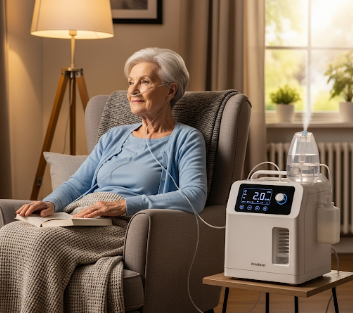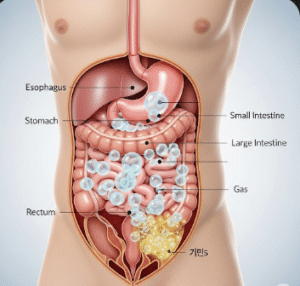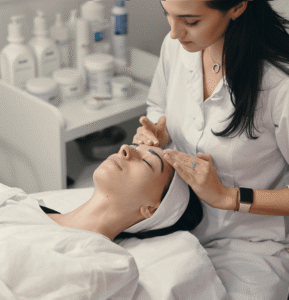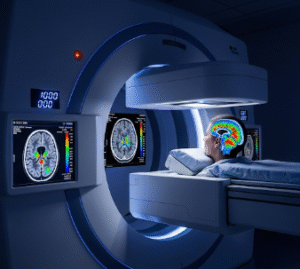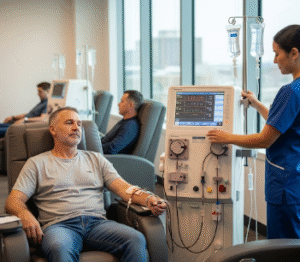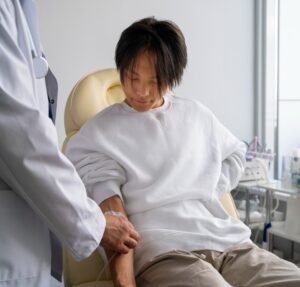What it is
Oxygen therapy, often referred to as home oxygen therapy (HOT) when administered outside of a hospital setting, is a medical treatment that provides additional oxygen to patients whose blood oxygen levels are insufficient. Adequate oxygen is essential for the body’s tissues and organs to function properly. Low oxygen levels, or hypoxemia, can lead to fatigue, shortness of breath, heart problems, and organ dysfunction if left untreated.
In Korea, home oxygen therapy is widely available and prescribed for patients with chronic respiratory conditions, cardiac problems, or other illnesses that affect oxygen levels. Modern medical facilities and specialized home healthcare providers ensure that patients can safely receive oxygen therapy at home with advanced equipment, continuous monitoring, and professional guidance.
Oxygen therapy can be delivered in two main ways:
- Hospital oxygen therapy → Administered via oxygen tanks, concentrators, or nasal cannulas during hospital stays.
- Home oxygen therapy (HOT) → Patients receive oxygen at home through portable or stationary oxygen concentrators, liquid oxygen systems, or oxygen cylinders.
Home oxygen therapy is typically intended for long-term management of chronic conditions rather than short-term, acute treatment. It is usually prescribed when blood oxygen saturation consistently falls below 88–90% at rest or during sleep.
Why it’s done
Oxygen therapy is prescribed for several medical reasons, including:
- Chronic obstructive pulmonary disease (COPD) → Patients with emphysema or chronic bronchitis often have impaired lung function and low oxygen levels.
- Pulmonary fibrosis → Scarred lung tissue reduces oxygen absorption.
- Heart failure → Inadequate circulation can lead to low oxygen delivery to tissues.
- Severe pneumonia or COVID-19 complications → Oxygen supplementation helps maintain normal oxygen levels during recovery.
- Sleep apnea or nocturnal hypoxemia → Oxygen may be used alongside CPAP or other therapies.
- Other chronic lung or cardiovascular conditions → Oxygen therapy improves quality of life, exercise tolerance, and overall survival.
Key benefits:
- Reduces fatigue and shortness of breath.
- Enhances exercise capacity and daily activity.
- Supports organ function by maintaining proper oxygen levels.
- May prolong life in patients with chronic hypoxemia.
Alternatives
While oxygen therapy is often essential for chronic hypoxemia, some alternatives or complementary approaches exist:
- Pulmonary rehabilitation → Exercise programs to strengthen respiratory muscles.
- Medications → Bronchodilators, steroids, or antibiotics to manage underlying lung conditions.
- Lifestyle adjustments → Smoking cessation, weight management, and avoiding pollutants.
- Non-invasive ventilation → CPAP or BiPAP devices for sleep apnea and respiratory support.
- Surgical interventions → Lung volume reduction surgery or transplantation in advanced cases.
Note: Alternatives are typically adjuncts rather than replacements for oxygen therapy in patients with severe hypoxemia.
Preparation
Before starting home oxygen therapy, patients should follow several preparatory steps:
- Medical evaluation
- Comprehensive assessment by a pulmonologist or cardiologist.
- Blood tests, arterial blood gas analysis, or pulse oximetry to determine oxygen needs.
- Equipment selection
- The doctor prescribes an appropriate oxygen delivery system (concentrator, cylinder, or liquid oxygen).
- Determining the required flow rate (liters per minute) based on activity levels and blood oxygen readings.
- Home setup
- Ensuring adequate space and ventilation for oxygen equipment.
- Securing oxygen cylinders to prevent tipping or accidents.
- Patient and caregiver education
- Training on proper use, cleaning, and maintenance of equipment.
- Understanding safety precautions, such as avoiding open flames or smoking near oxygen sources.
How it’s done
Administering home oxygen therapy involves several key steps:
- Device setup
- Stationary oxygen concentrators → Plugged into a power source, continuously supplying oxygen through a nasal cannula.
- Portable concentrators → Battery-operated devices for mobility.
- Liquid oxygen systems → Stored in insulated containers; oxygen is vaporized and delivered through tubing.
- Oxygen cylinders → Compressed oxygen delivered via regulators.
- Delivery methods
- Nasal cannula → Soft prongs placed in the nostrils; most common for home use.
- Face mask → Provides higher oxygen concentrations for patients needing more support.
- Transtracheal catheters → Surgically inserted in some cases for long-term use.
- Monitoring
- Regular checks of oxygen saturation using a pulse oximeter.
- Adjusting flow rate as per physician instructions.
- Scheduled follow-ups to evaluate effectiveness and make adjustments.
Daily care
- Clean nasal cannulas, masks, and tubing regularly to prevent infections.
- Ensure equipment is functioning correctly and safely.
Recovery
Recovery or improvement with oxygen therapy depends on the underlying condition:
- Chronic conditions → Oxygen therapy does not cure lung disease but improves symptoms, energy levels, and quality of life.
- Acute illness → Patients with pneumonia or respiratory infections may experience faster recovery and better oxygen saturation with temporary oxygen support.
Typical expectations:
- Reduced shortness of breath within days to weeks.
- Increased stamina for daily activities.
- Improved sleep quality if nocturnal oxygen therapy is required.
- Gradual stabilization of oxygen levels monitored by healthcare providers.
Long-term usage: Some patients may require continuous oxygen therapy for years, with periodic reassessments to adjust flow rates or delivery systems.
Complications
While home oxygen therapy is generally safe, potential risks and complications include:
- Fire hazards → Oxygen supports combustion; smoking or open flames near equipment is extremely dangerous.
- Nasal dryness or irritation → Frequent with nasal cannulas; using humidifiers can help.
- Skin irritation → Pressure sores from masks or cannula tubing.
- Oxygen toxicity → Rare, usually from excessive oxygen over prolonged periods; monitored by the physician.
- Equipment malfunction → Power outages or device failures may disrupt therapy; backup oxygen is recommended.
Regular monitoring and adherence to safety guidelines greatly reduce the risk of complications.
Treatment Options in Korea
Home oxygen therapy is widely available in Korea through hospitals, specialized clinics, and medical equipment suppliers. Key features of the Korean system include:
- Hospitals and clinics
- Seoul National University Hospital (SNUH) → Offers comprehensive respiratory care and home oxygen prescriptions.
- Asan Medical Center → Provides long-term oxygen therapy programs with home follow-up.
- Samsung Medical Center → Monitors patients with chronic lung disease and provides training for safe home oxygen use.
- Home healthcare providers
- Certified companies supply oxygen concentrators, liquid oxygen, and cylinders with delivery and maintenance services.
- Respiratory therapists may visit homes for equipment checks and patient training.
- Insurance coverage
- National Health Insurance in Korea often covers part of the cost of home oxygen therapy for eligible patients.
- Private insurance may provide additional coverage for equipment rental or specialized care.
Additional support
- Pulmonary rehabilitation programs are often paired with home oxygen therapy.
- Patient support groups and online resources assist with adaptation and lifestyle adjustments.
Conclusion
Home oxygen therapy in Korea is a safe and effective treatment for patients with chronic or acute low blood oxygen levels. It improves quality of life, stamina, and overall health while allowing patients to manage their conditions safely at home. Modern devices, home healthcare services, and specialized programs make oxygen therapy accessible and convenient, helping patients maintain daily activities and improve long-term outcomes.

